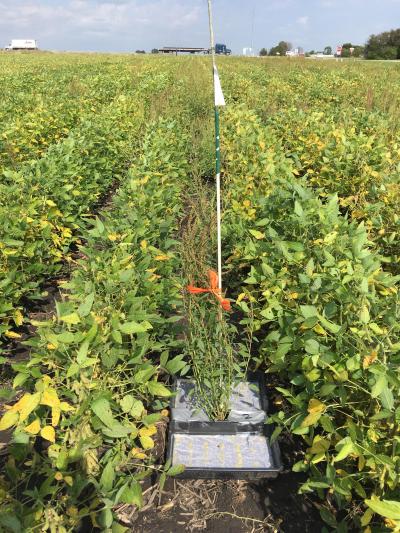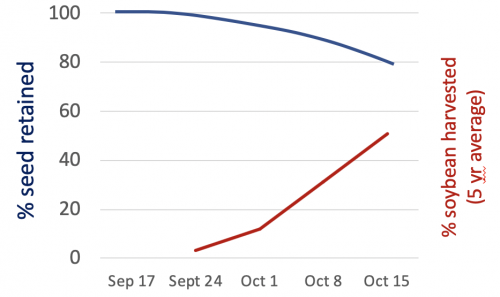Combines are the most important seed dispersal mechanism for weeds in our cropping system. While a small amount of seed may leave the field with grain, most weed seed that enter the combine with the crop are either spread throughout the field or carried to other fields. Harvest weed seed control (HWSC) involves modifying combines to prevent weed seed present at harvest from being added to the field’s seedbank. Waterhemp is the weed likely to drive the adoption of HWSC in Iowa. For HWSC to be effective, waterhemp must retain the majority of seed prior to harvest.

Seed traps for determining seed loss.
I conducted a simple demonstration to evaluate seed retention on waterhemp growing in soybean at the ISU AEA Research Farm near Boone, IA. Three waterhemp plants, ranging from 42 to 48 inches in height, were selected. Two trays were placed under each plant on Sept. 17 (Figure 1). Every 7 days the trays were emptied and seed cleaned from other material in the trays. After four weeks of seed collection (Oct 15) the plants were harvested and seed remaining on plants was collected and cleaned. I assumed that the traps captured 50% of the seed shed by plants. Seed quantity was determined by weight rather than counts, and seed loss was calculated by the cumulative amount of seed in the trays compared to total seed production.
Nearly 80% of the waterhemp seed was retained by plants on Oct. 15, the final collection date (Figure 2). The rate of seed drop increased over time, thus delays in harvest will result in less waterhemp seed entering the combine. Weed scientists at the University of Illinois conducted more detailed research with waterhemp over three growing seasons. Seed retention declined to 80% on Sept. 24, Oct. 6, and Oct. 12 in the three years. Researchers in Australia used computer models to simulate the benefit of HWSC in herbicide resistance management. Capturing 50% of weed seed via HWSC delayed the evolution of resistance by 10 years compared to when all weed seed was returned to the seed bank. These findings indicate that HWSC could be an effective tool for managing waterhemp.

Retention of waterhemp seed, Boone, IA, 2019. USDA Crop Progress Reports.
The continued evolution of herbicide resistant weeds is driving the need for alternative management tactics. HWSC is a tool that can be incorporated into our current production system easier than many other strategies. Research at Iowa State University will evaluate how to best adapt this strategy to Iowa’s production system.






Post a comment
Report Abusive Comment